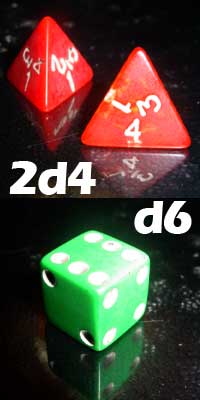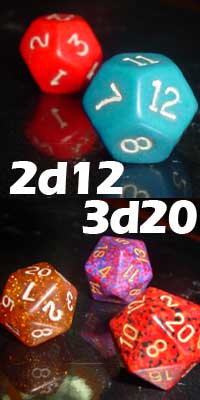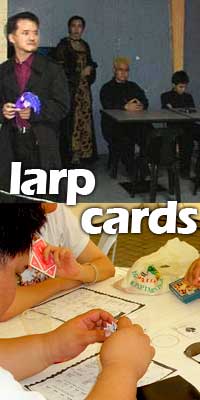article:
HOW ARE ROLEPLAYING GAMES
SET UP AND RUN?
By Tommy Lim
Setting Up
At its simplest, an RPG needs a Game Master, Players, the rules, the characters, and the story or objective setup.
Game Master.This is the person responsible for setting up the game's story, objectives, selecting which set of rules will be used, and later arbitrating the game and furthering its story. The Game Master also takes the role of all the other characters present in the game world. This person depending on the game publication used is sometimes referred to as Dungeon Master, Storyteller, Referee, Administrator, or Host. To make an analogy to movies, the Game Master serves as a collaborative director, part screenplay writer, set and production designer, cinematographer, props, sets, supporting cast, and extras.
Players. The players play the characters involved in the game. They use the character's abilities and play out the character's personality and make the character's decisions in order to achieve the objective or further the story. Players in the movie analog are the actors and by their play serve also as co-screenplay writers.
The Rules. In the hobby this is referred to as the Game System. It is a collection of descriptions, definitions, probability tables, and resolution tools to help the Game Master and the Players maintain consistency in the fantasy world. The Game System defines what is, what can and can't be done, and what determines an action's success or failure. Dice and sometimes playing cards are used to generate the random or partially random numbers to make the rules work.
The Characters. These are the player's "playing pieces" in the game. Game Systems have sections defining how characters are created. The characters are usually created by the Players. Sometimes a published adventure will have pre-generated characters. Sometimes the Game Master will pre-generate the characters. The facts and figures that define the character (e.g. strength, skills, etc) are written on paper. These facts and figures work with the game system in resolving actions.
The Story or Objective Setup. Characters can't just exist. They need a world to inhabit. They need things to do in that world. The Game Master is responsible for creating the impression of the world around the characters and making it react accordingly. Having a story to unfold or an objective to achieve gives the character purpose in its world.
Running the Game
The Game Master designs his world, selects the game system to use, and puts the story elements in place. The Players select or design their characters according to the game system and whatever conditions the Game Master has set for his story or adventure.
After all that is done, the game can begin. Mechanically the game consists of a series of dialogue and action. Here is a simple example of how play could go.
Player 1 (P1): A human fighter, named Michael
Player 2 (P2): A dwarf fighter, named Durag
Game Master (GM)
Situation: The players P1 and P2 have their characters stuck inside a cave. They find a rather straight crack in the wall and P1 suspects that there may be a door there.
P1 to GM: "I look in my backpack for the rusty spike I picked up earlier."
GM to P1: "Ok, you found it."
P1 to P2: "Durag, lend me your hammer."
P2 to P1: "What are you going to do with it?"
P1 to P2: "I think there's a door here. I want to drive the spike in to pry it open"
P2 to GM: "I look where Michael is pointing and I study it."
The GM determines that the dwarf has a chance of seeing something the human does not and he asks for a die roll (dice are used as randomizers for probabilities).
P2 rolls (gets a good die result)
GM (whispers to P2 so P1 won't hear): "Durag notices that the stones in the area flanking the passage are rather unstable."
P2 to P1: "Michael, I'm not sure of this. This may be a trap. Or at the very least we might cause a cave in."
P1: "Now what do we do? We've been stuck in this cave the whole day."
P2: "We can risk it. But why don't we try someplace else first? I just don't like the feel of this place."
P1: _______________________________________
(reader participation, fill in the blank with what you would say or do as Michael)
If you stepped into Michael's shoes and found something appropriate to put in the blank, welcome to role-playing!
And the play goes on.
WHY DO PEOPLE PLAY RPGs?
Why do people do what they do? Ask several people the same question and you'll get a nice variety of answers.
Gamers play for varying reasons too. Usually they play not for one reason but a combination of them. Also, they might play one game for one reason and play a different one for another.
Here are some of the reasons an RPG player plays:
Fantasy Character or Setting
The player's thrill comes from playing a well-known character or in a well-known setting. He may be playing Marvel Superheroes' Spider-Man or DC Heroes' Superman. Aside from comic book superheroes some other characters and settings that have made their way into RPGs are those from Conan, Star Wars, Indiana Jones, Star Trek, Bubble Gum Crisis, Sailor Moon, Macross, Teenage Mutant Ninja Turtles, Pendragon (the Arthurian Legends), and Lord of the Rings. In these game settings the players can of course choose not to play the established characters and instead make their own.
Simulation
The player likes to experience a different aspect of realism. He may be a student or maybe a manager at a company but would like to imagine what it's like to be British SAS on covert operation. This kind of player likes having game rules or game systems that can simulate reality accurately. While most game systems might group guns simply as pistols, semi-automatics, and rifles a simulation player likes the systems that go into more detail so he can specify HK-MP5, Glock 17, 9mm Beretta, or the like.
Method Acting
Some refer to this as deep role-playing. The player derives his enjoyment from stepping into the personality of his fictional character. This kind of player immerses himself in the world, emotions, and outlook of his fictional character during play. Like actors do, this kind of player likes bringing the character to life in mannerisms, speaking style, emotion, values and preferences, joys and wishes, fears and flaws.
Objective or Mystery
This kind of player plays the game for the thrill of overcoming obstacles or unraveling a mystery all within a fantasy setting. Almost the polar opposite of Method Acting very often in this kind of play the personality of the character takes a back seat. Succeeding is the point in this kind of play.
Story
This kind of play is usually the result of the game master's efforts. The objective of the play is to make a viable story with proper progression through exposition - rising action - climax - denouement. A happy or tragic ending are viable options as they are in movies.
IN THE END
Setting up a tabletop, face-to-face role playing game does look like a lot of work, most so for the game master. But after one experiences the extent of the possibilities, it will not only make the efforts worthwhile but extremely rewarding. Like a great movie a well-run and well-played game will yield stories to tell, praises to heroes, and laughter from anecdotes.
|
Dice: There are many new shapes of dice today. The original dice set, though, had five types of dice: 4, 6, 8, 12, and 20-sided. These shapes are called polyhedra meaning, "having many faces". The five put together are referred to in geometry as the Platonic solids (named after the Greek philosopher Plato). A platonic solid is a polyhedron whose faces are all regular polygons (equilateral triangles for 4, 8, and 20-sided polyhedra, squares for 6-sided, and regular pentagons for the 12-sided) and whose vertices (points) define a bounding sphere. Their names in order of increasing number of faces are: Tetrahedron, Hexahedron (cube), Octahedron, Dodecahedron, and Icosahedron.

Gamer dice terms: Most gamers and many game systems refer to the dice by the number of faces, d4 refers to the 4 sided die. The others are d6, d8, d12, and d20 |

XdY system To make it easier for gamers to be able to state what kinds of dice were to be rolled during a game session, a system was devised on how one can declare the combination of dice that was to be rolled.
X basically was the number of dice you rolled. Y was the kind of die you would roll. If you have to roll five six-sided dice, the game master will call for a roll of 5d6. |

Ten Wins It: The first non-Platonic solid-shaped die to become popular is the 10-sided die. (d10) For many game systems, two d10s (of differing color or makings) are rolled together to get percentlile results.
|

Not All Use Dice: While most game systems use variations of how dice are rolled, some games do away with dice entirely and make use of alternate methods of game resolution. Live Action Role Playing (LARP), for example, tends to use a combination of hand signals and keywords. In keeping with the Victorian flavor of its milieu. R. Talsorian's game "Castle Falkenstein" uses playing cards instead of dice. Other games, use colored pebbles and the like.
|

Maps and People: Some games use grids and figurines to keep track of maps and the placement of characters in combat.
|
|